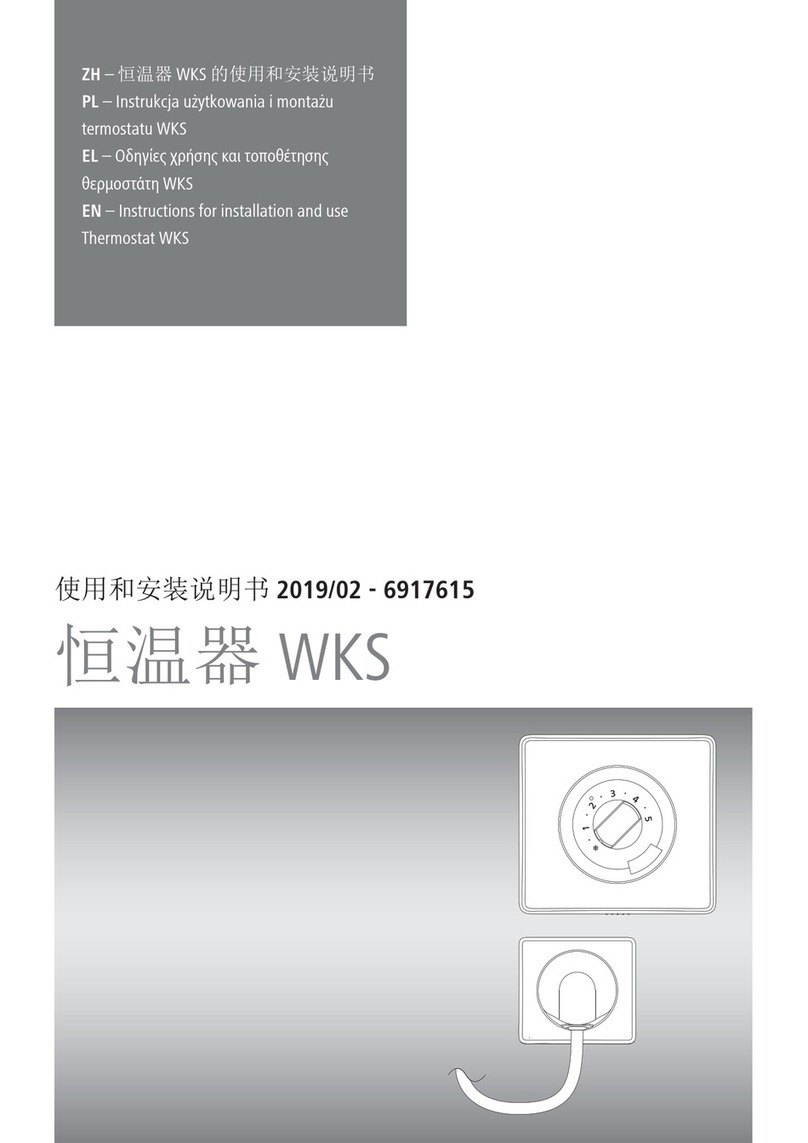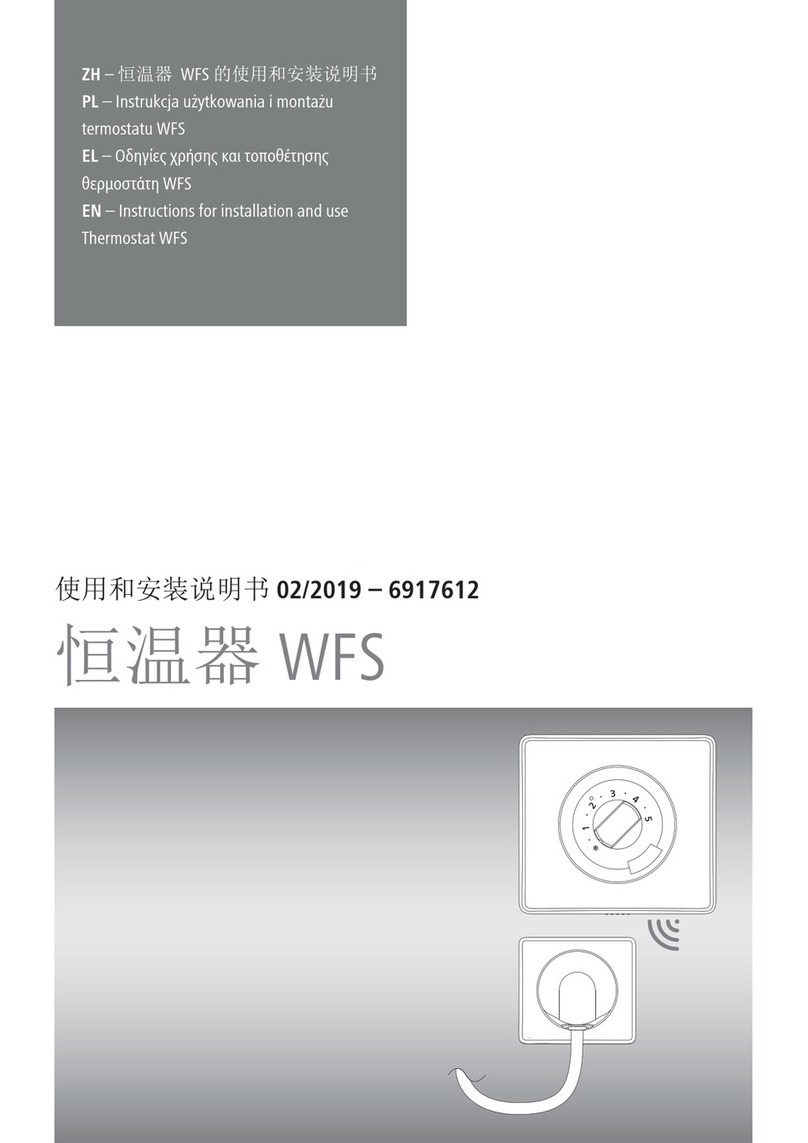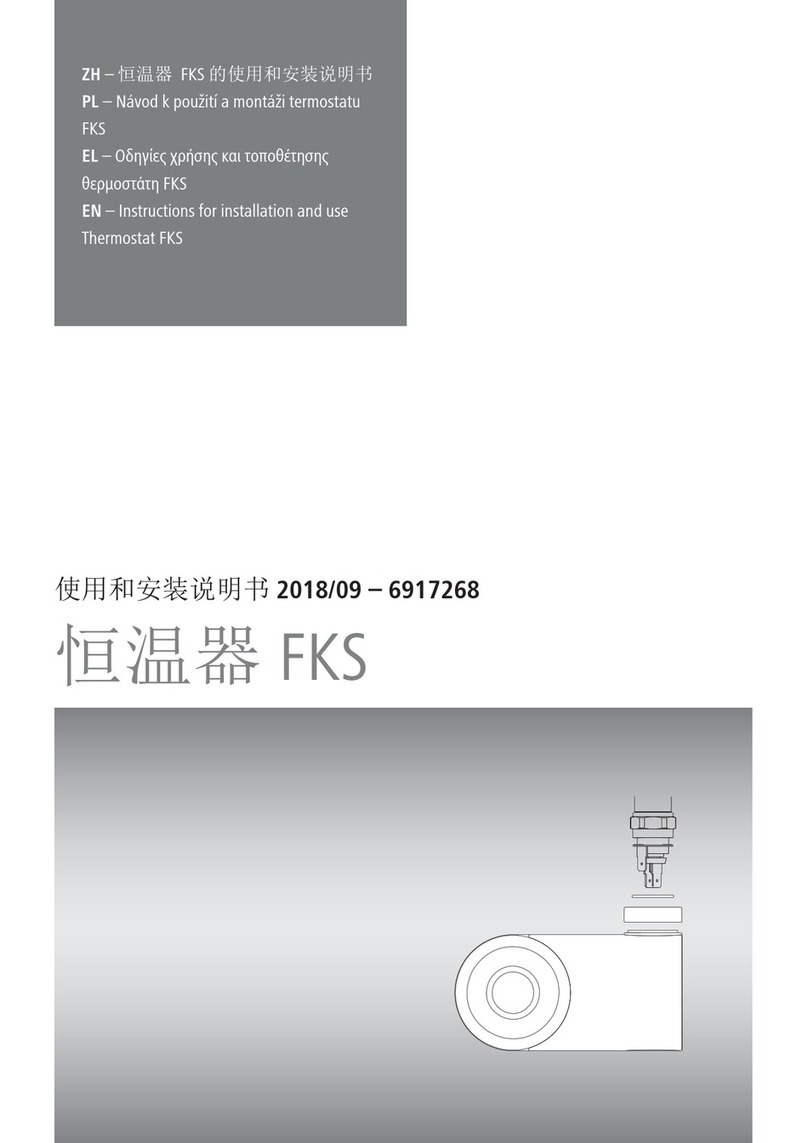
ZONE 30 is an electronic thermostat for electric underoor heating system with external oor
sensor.
ZONE 30 can be installed in standard wall box or ush mounted on the wall with an external
frame box.
ZONE 30 controls and regulate the oor temperature to achieve the best room comfort.
ZONE 30 are designed only to be used with KIMAs Warmoor Mat in oor constructions with
combustible material according to standard EN 60335-2-96.
ZONE 30 is using the adaptive PWM- and PI-technics to to give the best performance and to
extend ZONE 30s lifetime.
The only way to eliminate overtemperatures is to design the oor construction with the right
W/m2and compensate for the oor constructions thermal insulation and the Wattage per
square meter Warm Floor Mat.
If the buildings insulation properties is poor it can be compensated with another external
heat source. If ventilation/heat pump/air-condition are chosen as the external heat source
it is important that the temperature setting for this heat sources will not be lower than the
oor temperature, this will save energy.
The under oor heating construction should never be exposed to high temperatures to elimi-
nate the risk of re. The worst situation will be when the construction have a high power
output per sqm oor and the oor construction is thin with a good thermal insulation and
the oor surface will be covered with a carpet or any other good thermal insulating material.
The maximum allowed temperatures is depending on the surrounding material and regulated
by the electrical standards, regulations and directives.
- Maximum temperature in a oor construction according to electrical standards is 80˚C.
- The general maximum temperature for combustible material is 80˚C.
- Maximum operating temperature for the Heating Mat see the products
technical specications.
- The maximum temperature for water membrane are quite low (50˚C), see the
producers technical specications.
ZONE 30 complies with the directives for electrical safety and EMC compatibility.
ZONE 30 are CE-marked and complies with the following standards:
- EN 61000-6-2, EN 61000-6-3 EN 60730-1 and 60320-2-9.
ZONE 30 should only be used when the whole installation complies with electrical standards,
regulations, directives and KIMAs installation manuals.
ZONE 30 should only be installed by authorized installers.
If ZONE 30 have been exposed to violence or got damaged, it should be carefully controlled
by qualied personnel before it will be connected to the mains.
Installation oor sensor
It makes it easier if the oor sensor is installed in an end sealed electric conduit pipe, if it
needs to be replaced.
The oor sensor should be installed in an open oor area between two heating cables about
0,5 m from the wall. It is important that the sensor will not be placed in an area were the
heat can be thermally blocked with xed or movable furniture, wardrobes, kitchen cupboards,
etc.
If needed the oor sensor cable can be extended with a separate ordinary 1,5 mm2instal-
lation cable (maximum length see technical specications). The oor sensor should not be
installed in the same electrical conduit pipe as the heatingcables/heatingmats cold tail or
any other electrical cables. If the oor sensor is connected to a cable with metallic sheath.
Don´t earth the metallic sheath.
Economy function, Day or Night setback
Lowering the oor temperature with a preset value, see Technical specications, with an ex-
ternal signal. This function doesn’t need to be used if not needed. The external timer should
be installed on a suitable place for example at the switchboard or a manual switch that could
be installed next to ZONE 30. The timer or switch can control more than one thermostat at
the same time. Important to use the right control signal, see technical specications.
LED light will be green when the economy signal is active and red when the heatingcable/
heatingmat is energized. See Fig. 1
Frost protection
Frost protection will maintain the oor/room temperature at a low temperature, see techni-
cal specications. This function doesn’t need to be used if not needed. The external timer
should be installed on a suitable place for example at the switchboard or a manual switch
that could be installed next to ZONE 30.
The timer or switch can control more than one thermostat at the same time. Important
to use the right control signal (the signal should be connected via a rectier diode), see
technical specications. See Fig. 2
Installing ZONE 30
1. Open the plastic front cover and unscrew the screw. The thermostat should not be
opened in any other way.
2. Connecting cables (see g.)
Terminal 1: Live (L)
Terminal 2: Neutral (N)
Terminal 3-4: Heatingmat (Maximum Load 3600W/16Amp)
Terminal 5-6: Floor sensor
Terminal S: Control signal from external timer or switch to operate Economy function,
Day or Night setback or Frost protection if decided to use.
PS. Before the Heating Mat is connected to ZONE 30 the resistance and insulation
properties should be checked. See Heating Mat installation manual.
3. Install ZONE 30 with the frame against the wall or over a wall box and x it with screws.
Fit the covers.
4. Don’t turn the heating on to early, before concrete or liquid concrete have cured
enough. See manufactures specications.
5. LED light will be red when the Heating Mat is energized. Depending
on the thickness of the oor construction and how low surrounding temperature are, it
will take longer time to achieve set temperatures. If the heat losses are high, it could
be a problem to achieve set temperatures.
If their will be no heat, see fault nding list.
Documentation
Installations manual, Users manuals and any other documents for the oor construction
should be led near by the switchboard together with Warranty documents that can prove
that it has been an authorized installer that are responsible for the installation.
Environmental disposal
ZONE 30 is an electronic product and should therefor be returned to any envi-
ronmental approved depo stations.
Products marked with this symbol can’t be disposed together with the normal
household waste. It should be delivered to a waste collection centre in
accordance with the local regulations.
Faultnding ZONE 30
Fault tracing should be done by KIMA authorized fault nder.
The oor will not be warm
A. Check that the cables have been connected in the right way and the terminal screws
are tight.
B. Check the voltage on terminal 1 and 2.
C. Check that the switch on ZONE 30 is switched on. Check the voltage on terminal 3 and
4 when the Heating Heating Mat is on and the LED light is lit as said in
paragraph 5. Measure the electric current with a clamp meter and compare it with the
technical specications for the Heating Mat
D. Disconnect the Heating Mat and check the total resistance and the insulation
properties and compare them with the recorded values from the installation
that should be led near the switchboard and compare it with the technical
specications.
E. If the measured electrical values are correct according to the technical specications
and the construction doesn’t get warm enough the problem could be that the heat
losses are greater than the input power and the reasons could be cold spots. (PS. Do
not increase the power out put, that will instead increase the risk of re and also
shorten the ageing properties of the Heating Mat) Analyze the total building
constructions insulation properties and try to nd any cold spot that can
cause the problem. If the oor construction is a concrete slab on the ground check
the moisture, that could be a great problem due to better heat conductivity. Another
problem could be that their is a could area under the oor construction and that’s why
it important to insulate the construction well.
F. Disconnect the oor sensor on terminal 5-6 and there will be an error code in the LCD
display ”E1”, the LED light will ash red once. The same will happened if terminal 5-6
are shortened.
G. Check the oor sensors resistance and compare it with the technical specications.
The reading should only change with the temperature.
H. If ZONE 30 are turned on and the surrounding temperature are lower than -20˚C,
ZONE 30 will turn the relay off and when the temperature increase over -20˚C it
will turn on again.
I. If the temperature in the thermostat will be greater than 70˚C it will turn the relay of
for 10 minutes so the temperature will decrease and the LED light will ash red ve
times and a error code ”E5” will be presented in the LCD display.
J. Contact the distributor ZONE 30 has been purchased from.
The oor is energized all the time
a. Check that the cables have been connected in the right way and the terminal screws
are tight.
b. Disconnect the oor sensor on terminal 5-6 and there will be an error code in the LCD
display ”E1”, the LED light will ash red once. The same will happened if terminal 5-6
are shortened.
c. Check the oor sensors resistance and compare it with the technical specications.
The reading should only change with the temperature.
d. Contact the distributor ZONE 30 has been purchased from.
Problem programing ZONE 30, see Users manual.
Error codes in the LCD display
E1 - Sensor fault. The sensor are shortened or disconnected. The LED light will ash red
once.
E5 - Overheating. The temperature will be higher than 70˚C in the thermostat and
the relay will be switch off for 10 minutes so the temperature will decrease and the
LED light will ash red ve times.
Programing ZONE 30
See Users manual.
Warranty
Installation should be done by an authorized installer according to regulations, directives
and KIMAs installation manual.
Installation manual
KIMA ZONE 30
INST0104011 Rev 111121
www.kima.com
LCD Display
Red, increase
temperature
Programming
button
Blue, decrease
temperature
On/Off,
switch
Part no.: E8581137
EAN no: 7331002600091
Version 2
Fig. 1 Fig. 2
























